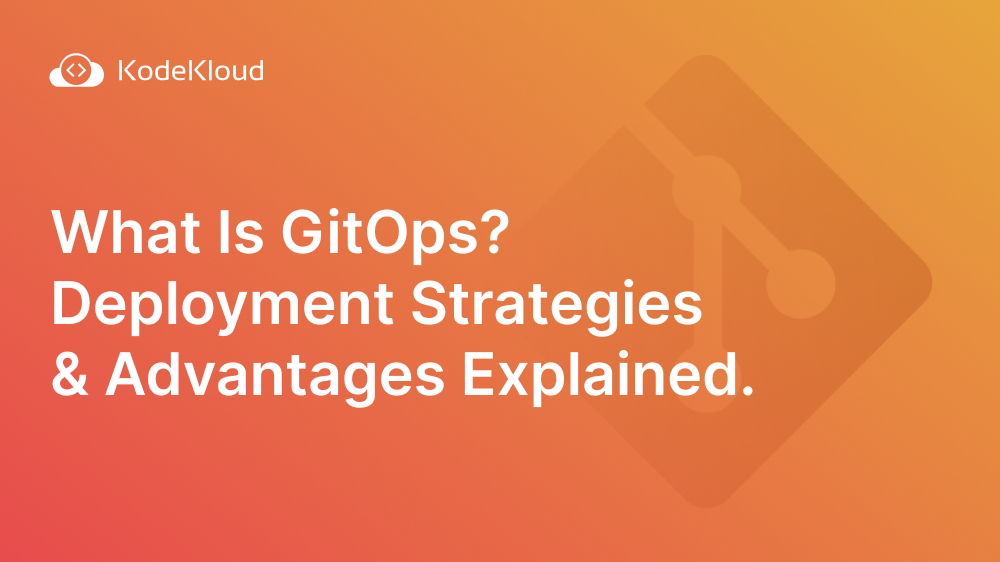GitOps is a term that has been around for a while but has recently gained popularity in the DevOps and software engineering communities. GitOps takes DevOps' best practices, such as collaboration, version control, and compliance, and applies them to infrastructure automation. So, let's start by understanding DevOps.
DevOps is a set of practices that aims to bridge the gap between development and operations teams. It emphasizes collaboration and communication between these teams to ensure that applications are developed, tested, and deployed quickly and efficiently.
What is GitOps?
GitOps is a method of implementing continuous deployment for cloud-native applications. It uses Git as a single source of truth for declarative infrastructure and applications. With GitOps, the entire system is described declaratively, stored in a version control system, and automated with CI/CD pipelines.
This allows for a transparent and auditable system where changes are made via pull requests and can be reviewed before being applied.
GitOps Deployment Strategies
GitOps deploys changes to the infrastructure using either a push-based or pull-based deployment. Below is an explanation of the two deployment strategies.
Push-Based Deployment
This is how the push-based deployment strategy works:
- You make some infrastructure changes and push them to the Git repository.
- The change in the Git repository triggers a series of commands in the pipeline.
- The commands then push the updated changes to the infrastructure, updating it with the latest version.
This push-based model aligns with the GitOps principles of using Git as the single source of truth and automating the deployment process based on the changes pushed to the repository.
It enables a streamlined and automated workflow where changes made through pull requests trigger the deployment pipeline, ensuring that the entire system is kept in sync with the declarative state described in the Git repository.
Pull-Based Deployment
This is how the pull-based deployment strategy works:
- You make infrastructure changes and push them to the Git repository.
- The infrastructure then automatically pulls the latest updates and applies them.
This can be done using tools like Argo CD. Essentially, Argo CD is like having an agent in your infrastructure that's always on the lookout for changes in your Git repository. Argo CD connects to the repo, and when it detects changes, it pulls the latest version and applies it to your infrastructure.
One key benefit of using Argo CD is that it always keeps your infrastructure in sync with your Git repository.
For example, if you were to change your infrastructure manually, Argo CD would detect this and realize that there is a difference between what's in the Git repository and what's in the actual infrastructure. And here's the cool part - Argo CD is smart enough to revert those changes and ensure that your infrastructure's state is the same as the state defined in the code in the Git repository.
In other words, Argo CD ensures that Git is the single source of truth regarding the state of your infrastructure. This is what GitOps is all about—using Git as the authoritative source of information about your infrastructure so that your team is always on the same page.
Push-Based vs. Pull-Based
The main difference between push-based and pull-based deployment strategies is the initiator of the deployment process. In push-based, you initiate the process, while in pull-based, the infrastructure initiates the process.
Now that you understand how GitOps works let's talk about its advantages.
Advantages of GitOps
Here are the key benefits of incorporating GitOps into your workflow:
- It makes your infrastructure secure and reliable: With Git's version control and approval workflows, changes to the infrastructure can be tracked and reviewed by authorized personnel, reducing the likelihood of mistakes or unauthorized modifications. This results in a more secure and reliable infrastructure.
- It introduces a controlled approval mechanism in the workflow: This helps ensure that any modifications are thoroughly reviewed and approved by designated personnel, reducing the risk of human error and accidental changes. By having a clear approval process in place, you can have peace of mind that your infrastructure is always in good hands.
- It allows for changes in infrastructure to be traced easily: Every change made to your infrastructure is recorded and tracked, so you have a clear and detailed history of all modifications. This makes it easy to see what was changed, when it was changed, and by whom. And if there's ever a problem, you'll have all the information you need to quickly identify and fix it.
- It allows for easy roll back to a previous version: With GitOps, if anything goes wrong or there's an error, you can easily revert back to a previous state in your infrastructure. This helps prevent prolonged periods of disruption and instability, and ensures your infrastructure stays in a known and dependable state.
Now that you know the many benefits of incorporating GitOps into your workflow, you might be wondering how to get started with your learning journey. Don't worry; we've got you covered. We've put together a learning plan that will help you get started and on your way to becoming a GitOps expert in no time.
How to Learn GitOps?
First, you'll want to have a solid understanding of Git. It is a version control system and source code management (SCM) tool, widely used for software development. Git makes it easy to revert to a previous version of the code, manage and keep track of multiple versions of the code, and maintain the history of the code.
To get started, check out our course Git For Beginners. It's a story-driven and interactive learning experience, where you'll learn Git by doing.

Next, you'll want to have a good grasp of automation or infrastructure as code tools like Terraform or Ansible. We've got beginner-level courses available with hands-on labs to get you up to speed:
Finally, it's time to dive into the GitOps tools themselves, such as Flux or Argo CD. We've just launched a hands-on course for Argo CD, so make sure to check it out if you're interested. The course is called Argo CD.
Conclusion
GitOps is the application of DevOps best practices in infrastructure automation. With GitOps, you can ensure that the infrastructure is always in the desired state and that changes to infrastructure and applications can be easily tracked, tested, and deployed. The use of version control tools like Git makes the process of managing infrastructure and applications more secure and reliable, making it easier for teams to work together and make changes quickly.
For a more in-depth look at all the concepts and ideas behind GitOps and how it fits into the larger DevOps landscape, check out our YouTube video:
More on DevOps:
- Top 10 Cloud Computing Skills You Need in 2024
- Cloud Computing And DevOps: What You Need to Know
- How To Scale DevOps: People, Processes, and Platforms
- 4 DevOps Metrics You Need To Track Quality and Performance
- Top 15 DevOps Automation Tools You Should Learn in 2024
- 10 Essential DevOps Tools You Should Learn in 2024
- 17 DevOps Monitoring Tools to Learn in 2024
- How To Learn Cloud Computing



















Discussion